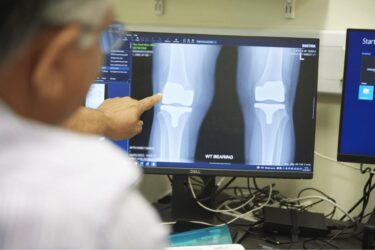Whether you’re researching how to know if you need a knee replacement or you’ve already had the operation, you’ll likely want to know the answer to this question. In this article, we explore the life spans of artificial knee joints, look at the latest technology in knee replacement, and answer the question: how long does a knee replacement last?

How long does a knee replacement last in the UK?
Following a successful operation and recovery process, between 85% and 90% of total knee replacement patients should expect their new knee to last between 15 years and 20 years. Some last much longer (beyond 20 years), while others need medical intervention sooner.
Factors affecting a knee replacement lifespan
Once you’ve had a knee replacement, it’s natural to look long term and want the joint to last as long as possible. The lifespan of an artificial knee joint depends on several factors. These include:
- the age of the patient at the time of their operation
- how healthy the patient is pre-operation
- how active the patient wants to be post-surgery
- the type of material used in the implant.
Younger patients may require a second operation to clean the bone surfaces and reset the implant.
Why do some people need knee revision surgery?
Knee revision surgery is typically needed when the artificial joint has failed. This is usually caused by the following: Injury, wear and tear, loosening and infection are among the most common indications.
- Dislocation or injury – This can occur following a sudden-impact accident or if the original implant was the wrong size
- Infection – This is the most serious complication of knee replacement. Symptoms include pain, instability and swelling of the joint. Patients with infected knee implants often require revision surgery
- Instability or loosening of the joint – This occurs when the bone fails to grow around the part of the knee with the knee implant. Patients with this issue are likely to experience knee pain, swelling of the joint, and partial or full dislocation of the joint
- Fracture – During a knee replacement, the implant is attached to the surrounding bones. When one of these fractures, this may cause the artificial implant to loosen.
How many times can a knee be replaced?
As the lifespan of an artificial knee joint is typically between 15-20 years, patients that received their knee replacement at a younger age are more likely to need revision surgery. This is supported by studies and reports. Patients can receive as many knee surgeries as needed, however, with each revision procedure, there is a higher possibility of losing more bone from around the knee. This can result in the increased likelihood of complications and risks in subsequent knee revision operations.
Pain in your knee?
If you’re experiencing knee pain, try out knee suitability quiz. It will give you an idea of whether you’d benefit from booking a consultation with one of our knee specialists.
Spot the signs and symptoms of a knee replacement wearing out
If your artificial knee joint fails, your doctor may recommend a knee revision operation as a solution. The signs and symptoms of needing a knee revision are:
- Dislocation or injury – This can occur following a sudden-impact accident or if the original implant was the wrong size
- Infection – This is the most serious complication of knee replacement. Symptoms include pain, instability and swelling of the joint. Patients with infected knee implants often require revision surgery
- Instability or loosening of the joint – This occurs when the bone fails to grow around the part of the knee with the knee implant. Patients with this issue are likely to experience knee pain, swelling of the joint, and partial or full dislocation of the joint
- Fracture – During a knee replacement, the implant is attached to the surrounding bones. When one of these fractures, this may cause the artificial implant to loosen.
Tips for looking after your new knee
After your operation, you’ll need to make sure you maximise your recovery time. Your consultant will provide a knee surgery recovery plan, containing physio and activities you should do that are aimed at strengthening the muscles around your new knee.
If you’re a cyclist, you’re in luck! Along with swimming, golf and walking, cycling after knee replacement surgery is one of the best post-knee op activities you can do. This is because it doesn’t place the knee joint under any weight-bearing strain.
However, there are still certain activities you should avoid. These are activities that carry a high risk of falling. Sports such as rugby, football and skiing should be avoided as these could cause damage to the new implant. Activities involving a lot of running and jumping should also be avoided, as well as sitting for prolonged periods of time.
The importance of rest and sleep shouldn’t be overlooked either. This will help promote recovery and, in turn, could improve your overall quality of life.
Knee joint replacement surgery FAQs
Haven’t quite found what you’re looking for? Our knee replacement surgery FAQs might be able to help!
Partial knee replacements tend to be carried out on younger patients between 55-64. This is because the artificial joint is expected to need revising after around 10 years.
It’s difficult to pinpoint how long a titanium knee replacement will last. Factors such as the patient’s lifestyle, activity levels, and age at the time of operation will all play a big part. However, there are pros and cons to the material. For example, titanium cobalt implants are biocompatible, which means they won’t wear, change or cause immune reactions inside the human body.
As with titanium and Polyethylene knee replacements, it’s difficult to definitively say how long a ceramic hip will last. One major advantage of ceramic implants is that they’re scratch-resistant. This means they’re much less likely to wear down over time and, hence, have a long life expectancy. The downside of ceramic implants is their cost and potential to shatter.
Plastic implants are often made from Polyethylene. This is mostly down to the technological advances made over the last few decades which have greatly reduced the risks of the plastic wearing down.
It’s very unlikely. There have been instances of knee replacements lasting longer than 25 years. However, the majority of reports and studies point to knee replacements having a lifespan of between 15-20 years.
Most studies show that around 90% of knee replacements last for 10 Years, while 80% last for 20 years. The longevity of a knee replacement depends on how active the patient is, their age, the material used in the implant, and how closely the patient followed their recovery physio plan.





